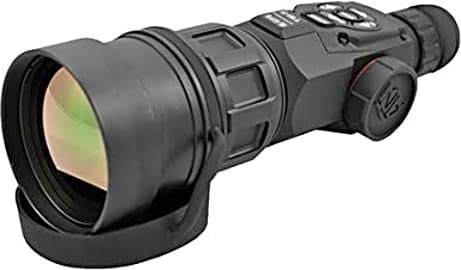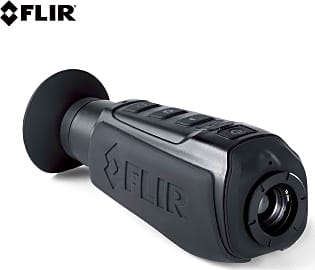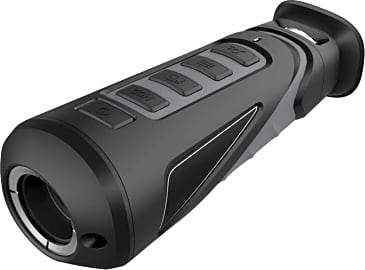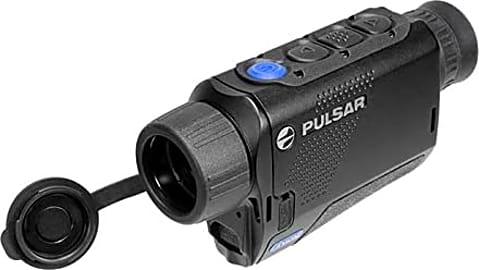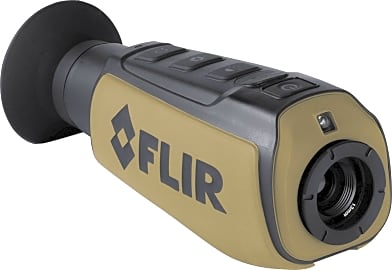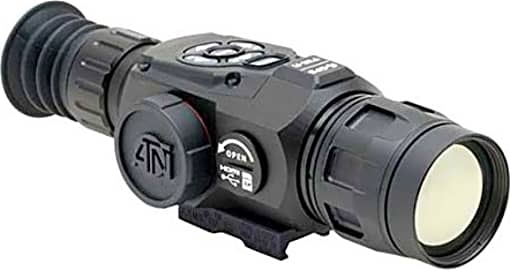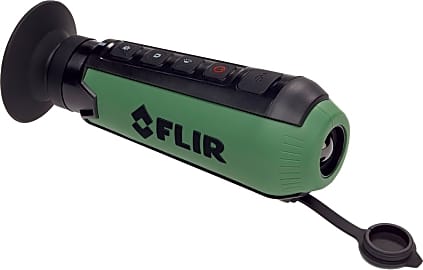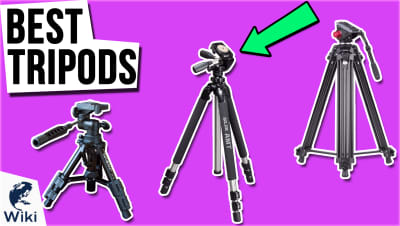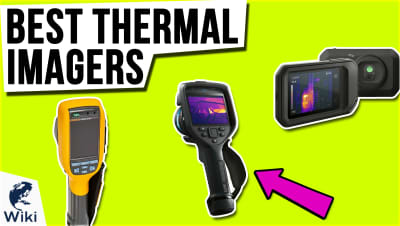The 10 Best Thermal Monoculars

This wiki has been updated 34 times since it was first published in March of 2017. When you're a law enforcement officer, a hunter, or part of a search and rescue team, you may find yourself in a situation where you want to track heat sources in low-light or completely dark environments. Unlike night vision devices, thermal monoculars can detect extremely small differences in temperature, which makes them especially effective for certain applications. When users buy our independently chosen editorial picks, we may earn commissions to help fund the Wiki.
Editor's Notes
November 04, 2020:
Today the high-sensitivity AGM ASP TM35-384 joins the list. This relative newcomer is proving itself a force to be reckoned with, thanks to its clear views day or night, and its ability to reliably detect and mark hot spots in your field of view. Like the highly rated Pulsar Helion XP, this one can record video and take snapshots. It’s lightweight at just one pound and is backed by a three-year warranty. It replaces the now-discontinued Pulsar Core FXQ38. In addition to the Helion XP, another Pulsar model that remains on our list is the Pulsar Axion XM30S, which includes a handy picture-in-picture setting that lets you zoom in on a given image while still showing you the rest of the field. It’s ergonomically designed with controls on the top for easy access, and it fits nicely into the palm of your hand.
Today we also swapped out the Leopold LTO Tracker with the updated Leupold LTO Tracker 2, which provides enhanced features like a beacon mode, which lets you recalibrate the screen quickly when you need to better identify objects with a similar heat signature to their backgrounds. This American-made choice still features durable gorilla glass, as its predecessor did. Four models are on the list from Flir, which announced in early 2020 that its products would start to focus more on the professional user involved in law enforcement or the military. However, the Scout, LS, and Breach outdoor thermal products would continue to be manufactured, all of which offer reliable and thoughtfully designed monoculars. The Flir LS-XR features raised buttons that are easy to press, even when you’re wearing gloves. It’s equipped with a hot object highlighting feature and a red laser pointer. The Flir Breach PTQ136 sports multiple mounting points for attaching it to a helmet or a rifle. It’s simple to control the brightness and zoom function, and to set it to your preferred color palette. The compact Flir Scout III weighs just 12 ounces and starts up in just a few seconds, and boasts convenient features like a utility light, a wrist strap, and a battery that can run for up to five hours between charges. Finally, the relatively inexpensive Flir Scout TK is a popular choice for anyone who doesn’t want to invest in a feature-packed model. It’s commonly used for those seeking some personal home security at night, including knowing where one’s dog is at in a dark backyard. It’s compact, easy to operate, and provides a decent field of view, although the range is more limited than many others.
July 04, 2019:
One feature that makes a big difference in terms of price is WiFi capability. Now, this obviously not a necessity for most applications — but chances are, neither is thermal imaging. It is convenient, though, as it allows you to quickly share your view with others, which could be critical for law enforcement. Also, it can open up other features, like the ability to use GPS. These can be lifesavers for hunters and hobbyists as much as for first responders.
The Pulsar Core FXQ38 has a noiseless shutter, which is one of those features you never think about until it's too late. Some models create a little bit of sound when cycling through features or zooming in; these noises aren't overpowering, but if you're often in situations where complete silence is the difference between life and death (for you or your prey), it's something worth insisting on.
Most of the options listed here are handheld, but a few — like the Flir Breach PTQ136 or the aforementioned Pulsar Core FXQ38 — can be used hands-free, either by attaching to a helmet, weapon, or other surface. This is obviously valuable for tactical purposes, but even hunters can find a use for it, especially if they like to go out in the field solo.
Special Honors
EOTech MTM-PI This unit can amplify ambient light in addition to picking up heat signatures, giving you multiple ways to track down your target. You can also hook up an LCD screen to it to give you a larger viewing area, reducing the likelihood that something will sneak past you. opticsplanet.com
Newcon-Optik TVS 11 Built to be either mounted on a tripod or held in your hand, this device functions just as well during the day as it does after the sun goes down. It can see through smoke and fog, making it ideal for search and rescue. newcon-optik.com
GSCI TLR-7150 If you're doing nocturnal surveillance, this powerful model will make sure nothing goes unnoticed. It also has a built-in DVR to capture anything noteworthy that happens overnight. gsci1.com
Warming Up To A Useful Technology
Law enforcement professionals benefit from thermal imaging devices, as well.
From James Bond to Jurassic Park, night vision has been a staple of American pop culture for decades. So, when it comes to the notoriety of high-tech optics, thermal imaging doesn’t really hold a candle to night vision. That being said, when you step back and analyze the components and uses of each, thermal imaging may very well be the most interesting and practical of the two.
While night vision devices require at least a little bit of light to operate, thermal monoculars detect radiation to project an image, rendering light unnecessary. Thermal imaging technology allows you to see extremely small differences in temperature — the hotter the object, the brighter the image will appear on the screen.
Because of this, thermal monoculars make it easier to detect things that are hotter than their surroundings, even in environments with little to no light. This is considerably useful for a range of applications where vision is paramount.
For example, firefighters need to be able to see people and pets in smoky conditions, often with debris blocking their line of sight. Thermal monoculars also help them identify areas within a burning structure that are the highest in temperature, which shows them where the blaze is at its fiercest.
Law enforcement professionals benefit from thermal imaging devices, as well. During tactical operations, officers are able to reveal potential threats where they would have otherwise been blind. Many of today’s police officers and military personnel are even equipped with thermal imaging rifle scopes for this very reason.
As you can likely imagine, thermal monoculars are widely popular among hunters. Lots of commonly hunted animals — such as deer and hogs — are most active at night or in low-light situations. A lightweight, versatile thermal monocular is a valuable asset for a hunter, allowing the user to hold it steady for long periods of time without succumbing to fatigue.
Because it’s equally effective during the day as it is at night, a thermal monocular is a useful tool for surveillance purposes. The same goes for performing energy audits on homes and buildings, where identifying an area that’s leaking heat can lead to repairs that will save users a hefty wad of cash on utility bills.
Discovering Your Ideal Monocular
Which thermal monocular you ultimately choose will depend on your intended use, your budget, and the level of portability you require. It shouldn’t come as a surprise that the most powerful options are typically larger and more complex than small, versatile models.
Whereas a hunter may spend an entire day using the device, a law enforcement official may only need it for a quick operation. In this case, the hunter — or someone tasked with long-term surveillance responsibilities, for that matter — will probably opt for something lightweight with a long-lasting battery. Conversely, the mission-focused soldier may prefer a heavy-duty monocular with multiple viewing modes, high resolution images, and the ability to store video.
Some of the most powerful options have zoom capabilities that can detect heat signatures at more than 1,000 yards away.
For some, the device’s magnifying power will factor heavily into which option they select. Thermal monoculars feature less magnification than standard monoculars, and the price tends to go up as the image gets sharper. Some of the most powerful options have zoom capabilities that can detect heat signatures at more than 1,000 yards away.
Since outdoor applications are some of the most common for these devices, they’re usually fairly durable and resistant to the elements. If there’s a chance you’ll be spending an extended amount of time outside in wet weather, you’ll want to make sure your model is fully waterproof. Some models can even adeptly cut through rain, snow, fog, hail, dust, and debris to detect heat targets — which is ideal for those who operate in extreme conditions.
You’ll also have to decide how important a color screen is to you. Some models come in full color, some only feature black and white, and others allow you to toggle between the two. Color mode may attract the most attention, but you can often observe greater detail when in black and white mode.
As technology advances, the selection of potential nifty features that accompany thermal monoculars gets more expansive. Some offer different operating modes tailored to the specific environment you’re in, such as a forest or a city. Others have Bluetooth capabilities, feature external back-up batteries, or come with tripod mounts. To narrow down your choices, prioritize attributes that are essential to how you’ll use it.
How Does Thermal Imaging Work, Anyway?
When you set out to use a high-tech device such as this, it’s crucial that you possess a satisfactory understanding of how it works — particularly if you’ll find yourself in an intense law enforcement or military situation.
Everything out there in the world produces energy in the form of heat. The amount of infrared energy an object radiates is proportionate to its temperature. Thermal imaging technology detects very subtle differences in temperature to reveal things to the user that would otherwise be invisible to the naked eye.
The circuit board inside the device processes these impulses, translating this data into images that will display on the digital screen.
The crown jewel of the thermal monocular is its special lens that focuses on the infrared light of all objects within its field of vision. When in use, numerous infrared detecting elements are active within the device. Working together, these elements pull from thousands of visual points in the lens’ view, then use this temperature information to create a detailed pattern called a thermogram. This all occurs within a fraction of a second.
The monocular quickly converts the thermogram into electric impulses. The circuit board inside the device processes these impulses, translating this data into images that will display on the digital screen.
In addition to monoculars, companies use thermal imaging technology to produce handheld thermal imaging devices and to create cameras for security and surveillance systems. Handheld models are convenient when long-range vision isn't important, and thermal cameras serve as a nice complement to standard cameras, allowing security and surveillance systems to offer comprehensive threat detection capabilities.


